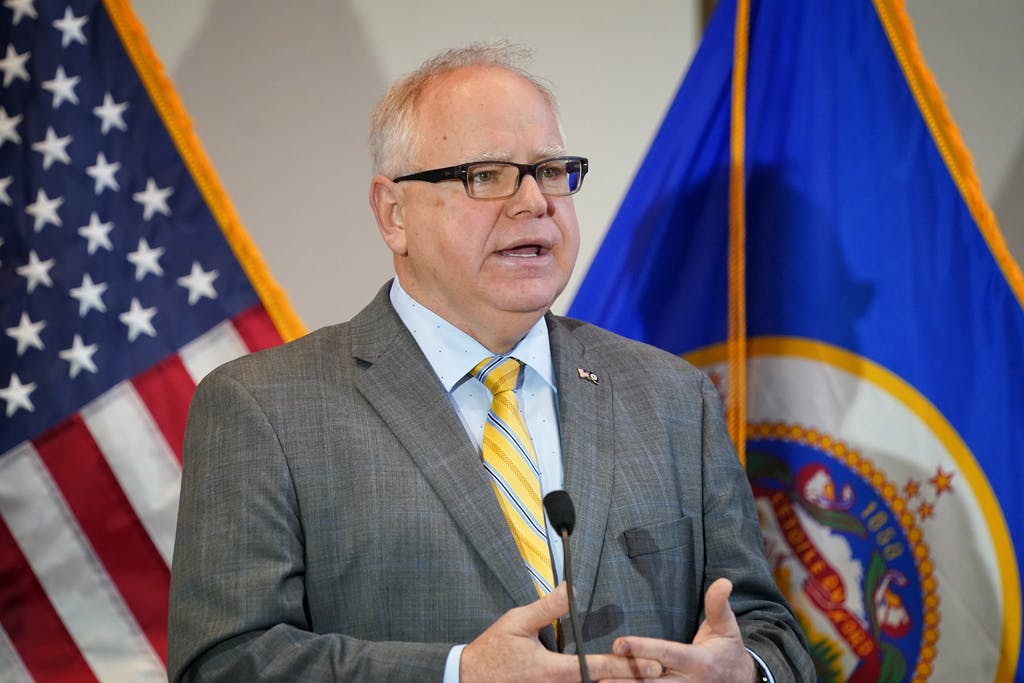Dine-in restaurants in Minnesota are being temporarily shut down along with bars, theaters, museums and other gathering places under an order by Gov. Tim Walz designed to slow the spread of the coronavirus that has now been confirmed in 54 state residents.
Walz issued the emergency measure Monday, one day after ordering the closing of K-12 schools statewide. The restaurants must close by 5 p.m. Tuesday. Schools will officially close Wednesday, though many districts already suspended classes.
The governor's order, made under "peacetime emergency" powers, also covers health clubs, theaters, museums, food courts, coffeehouses and other places of "public accommodation and amusement."
"We're not going to stop this from spreading," Walz said, "but we can stop how fast it spreads and we can make sure that we protect those most vulnerable."
Walz said Minnesota is at a "critical point" in its reaction to the pandemic and can follow the example of some nations in Southeast Asia that acted aggressively and are now recovering, or take the path of Italy and other countries that were slow to act and still face growing case numbers that have overwhelmed hospitals. He lamented that people were still gathering in large groups in bars and pleaded with Minnesotans not go to out for one final time.
With testing having now identified 54 cases of COVID-19 in Minnesota, some with no known source of transmission, state health officials warned that people should assume that the virus that causes this illness is in their communities.
Investigations couldn't trace the sources of infection for three patients in Hennepin, Ramsey and Dakota counties, meaning that the virus is spreading locally in what is termed community transmission and that more people are infected than are known.
"Those cases represent additional cases that didn't come to detection, because obviously they were exposed somewhere," said Kris Ehresmann, infectious disease director for the Minnesota Department of Health.
Walz acknowledged that the closures of schools, restaurants and entertainment venues is "incredibly disruptive" and could put thousands of Minnesotans temporarily out of work. He issued a companion executive order Monday to ensure that people who are laid off because of the outbreak would receive immediate unemployment benefits. The order also waived a surcharge on businesses that normally pays for the state's unemployment insurance trust fund, giving the business owners some relief.
The announcement came as state officials received a new economic forecast predicting a U.S. recession beginning in the second quarter of this year, and after a stunning, nearly 3,000-point drop in the Dow Jones industrial average.
Restaurateurs supported the move. "We cannot pretend that this real-world crisis is not happening," said Andrew Zimmern, a celebrity chef and restaurant owner who appeared with Walz.
Pickup and delivery services will be allowed, but health officials encouraged online payments for deliveries and no-contact exchanges when meals are dropped off.
Walz said the state's strategy is evolving and that additional orders governing places such as the Mall of America might be needed to reduce the spread of COVID-19.
The school and restaurant measures also could be extended beyond their current end date of March 27.
Walz tasked the schools with providing child care for health care workers and meals for students from low-income families, and said he was impressed by their response in only one day.
Testing of suspect cases by the state's public health lab had surged to 1,893 people as of Monday morning, but Ehresmann said the lab cannot maintain the current pace and will need to be judicious about future testing because of global supply shortages.
The state lab will prioritize testing of hospitalized patients and health care workers, whose results could have an immediate impact on the operations and staffing of health care facilities, Ehresmann said.
Minnesota's count now includes cases in Blue Earth and Benton counties. Three patients have been hospitalized, including an Anoka County person in the 30-to-39 age range who was admitted to a hospital in critical condition last week.
All other patients are recovering at home. Globally, studies of COVID-19 have found that at least 80% of infected people suffer only mild symptoms.
The state had discouraged meetings or events of 250 people just last week, but now discourages meetings of more than 50 people and gatherings of any 10 people who are considered at risk, such as the elderly and people with underlying health conditions. President Donald Trump on Monday went a step further and discouraged any gatherings of 10 or more people.
Organizations statewide took other steps to protect the public and preserve health care resources. M Health Fairview is canceling non-urgent elective surgeries starting March 18, a move that also could preserve the supply of donor blood. The Minnesota Board of Dentistry urged cancellation of elective dental procedures as well.
The University of Minnesota and University of St. Thomas canceled all in-person classes for the spring.
Given that some of the first Minnesota cases may soon be recovered, Ehresmann also provided guidance for all people with fever and respiratory symptoms. Those affected need to remain isolated when sick, and to stay isolated until they have been healthy for seven days and fever-free for three days.
People have flocked to free health care services to check the possibility they have been exposed to COVID-19, which is caused by a new coronavirus that first emerged in Wuhan, China, in December. M Health Fairview reported 1,400 visits just on Friday to its OnCare telemedicine service after announcing free assessments for COVID-19 testing. The health care provider reported 1,055 OnCare visits in all of December.
Ehresmann stressed that people whose symptoms are manageable don't necessarily need to leave their homes for testing or visit clinics or hospitals because so far there are no specific vaccines or medications.
"Since there is no treatment for mild cases, there is no clinical decision that would be made based on the test result," she said.
Hospitals have been planning for weeks for a surge in patients if the virus spreads widely in Minnesota, but Ehresmann said preventing cases is critical because beds and ventilators to treat the respiratory problems caused by severe cases could run short.
Recognizing the potential pressures on hospitals, legislative leaders said at a news conference Monday morning that they want to quickly pass a hospital aid package. As much as $150 million in grants or loans has been proposed.
As state health and political leaders ramped up responses to COVID-19, one group of Minnesotans affected for days already by the global outbreak received welcome news.
Travelers on the Grand Princess cruise ship are finally coming home after spending days in quarantine on the ship off the coast of California, followed by four nights at a military base in that state.
"We'll still be in quarantine once we get home but at least we will be home," said Darlene Judd of Coon Rapids, who said she was "absolutely thrilled" to be heading back.
Star Tribune writers Glenn Howatt and Jessie Van Berkel contributed to this story.

Single adults turned away from Hennepin emergency homeless shelters 4,000 times in 2023
Winona says it needs a new police station. Some residents (and officials) aren't so sure.

Why you should donate clothing: It (probably) won't end up at the dump



